13 March 1778 Friday
Vases, Candelabra, Grave Stones, Sarcophagi. Tripods, Lamps and Ancient Ornaments volume II
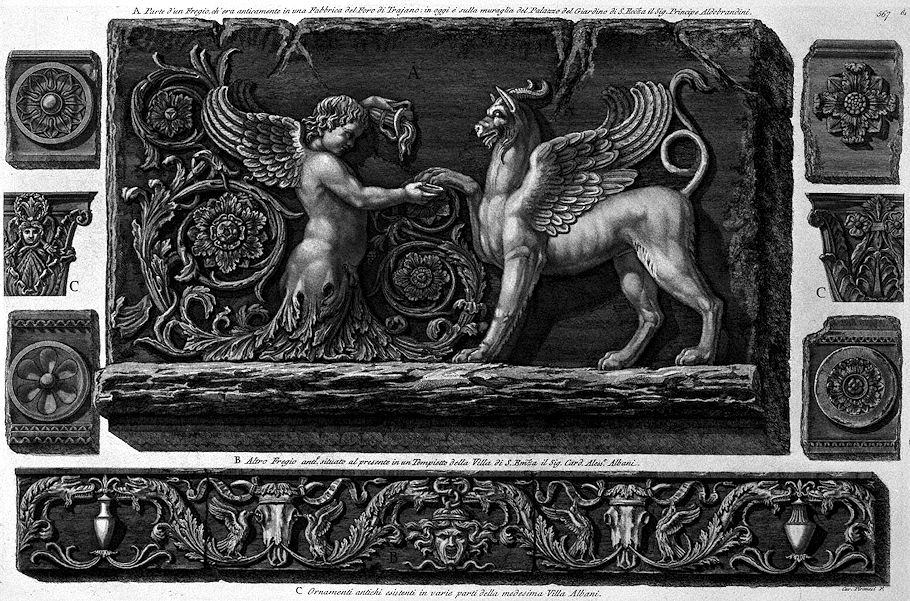
A Part of a Frieze, which was formerly in a Building of the Forum of Trajano: today it is on the wall of the Palace of the Garden of S. Ecc(ellen)za the Mr. Prince Aldobrandini.
B Other Antio frieze presently located in a small temple of the Villa of S. Em(inen)za the Cardinal Aless.o Albani.
C Ancient ornaments existing in various parts of the same Villa Albani.
Cav. Piranesi F.
22-23 y.o. Francesco Piranesi 1781
Pianta delle Fabriche esistenti nella Villa Adriana
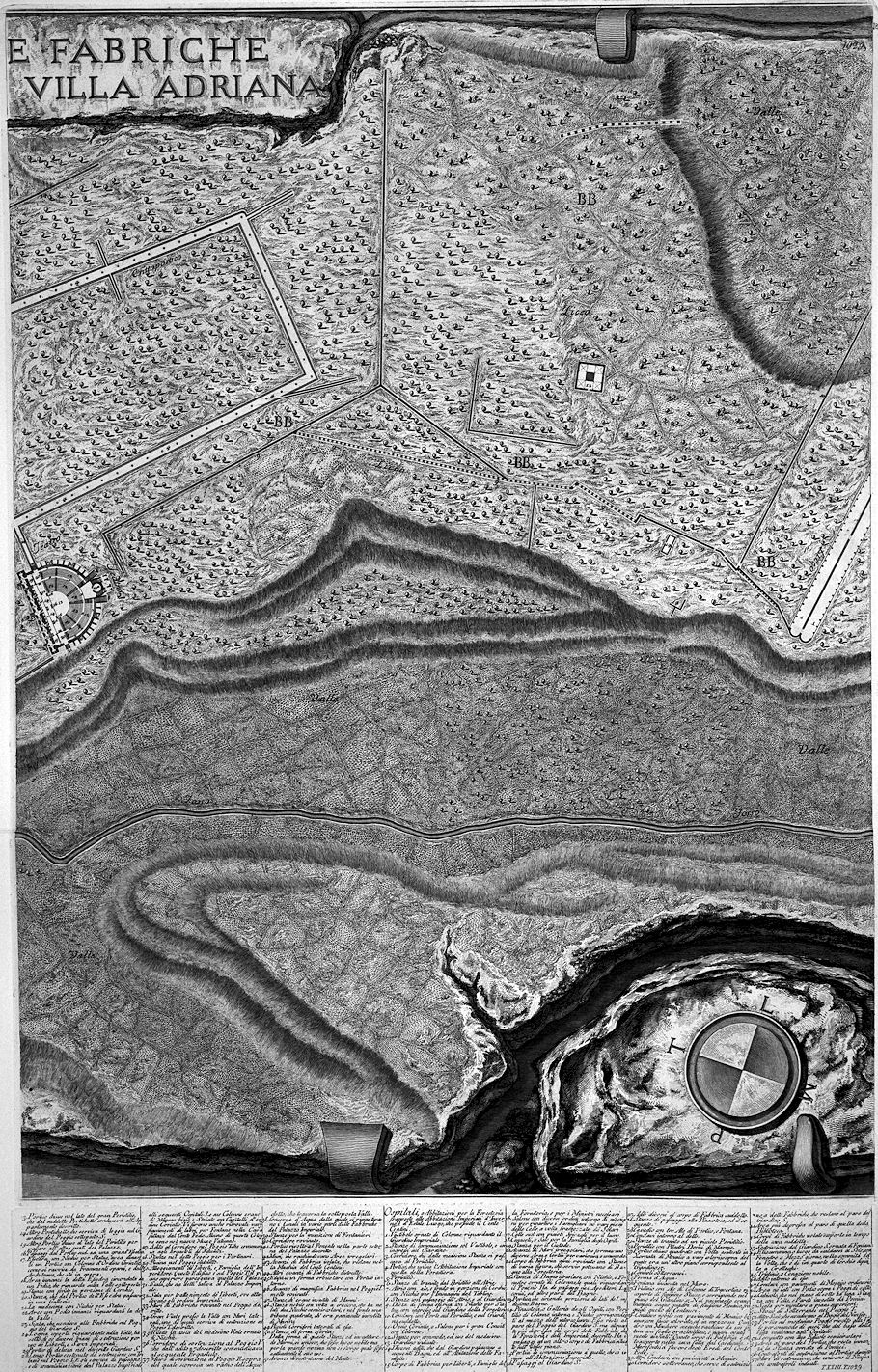
PLAN OF THE STRUCTURES EXISTING IN THE VILLA ADRIANA
13. Closed portico on the side of the large Peristyle, which led from the aforementioned Portichetto to the described Apartment. 14. Another Portichetto, which served as a loggia on the Garden of the Poggio below. S. 15. Another closed Portico to the side of the Peristyle to pass to the other parts of the Palace. 16. Passaggj from the South Portico. to a large Essedra. 17. Essedra with Niches for Statues, had in front of it a Portico with Columns of the Corinthian Order, as can be recognized from scattered Fragments, and from the Architrave, which is still in place. 18. Area in front of the said Essedra surrounded by a podium, which overlooks the underlying valley. 19. Stanze with back in portion of Circle. 20. Room, which from the Portico dell'Essedra passed into a Gallery. 21. The same with Niches for Statues. 22. Areas with Podium in front concerning the said Valley. 23. Staircase, which descended to the Factories on the Poggio del Giardino S. 24. Covered loggia overlooking the Valley, has below it several floors of construction for the use of the Freedmen and Imperial Servants. 25. Portico of Delight in the described Garden S. 26. Long Portico supported by support with Tribune on Poggio T. It served for walking, and for communication from the Imperial Palace to the following Hospitals. Its columns were of gray marble, and streaked with capitals of the Corinthian order. There were also found various fragments of labri for Fountains in the Cava made there by Count Fede. Some of these Columns are in the new Vatican Museum. 27. Appealed to the Corridore in Poggio T. which he communicates to the life sentences of the Slaves. 28. Rooms in the said Poggio for the Portinari. 29. Swimming pool in the aforementioned Poggio. 30. Lodgings of the Liberti, and the Emperor's Family. This Building is on Poggio T: the upper floor equaled that of the Palazzo. 31. Staircase, which from the above went up to the Imperial Palace. 32. Hall for entertainment of the Liberti, where they awaited the Imperial orders. 33. Walls of ruined factories in the Poggio described. 34. Gran Viale near the valley with lateral walls, one of which served as a substructure for the Poggio T. described. 35. Ricetto at the head of the same Viale adorned with Niches. 36. Corridor of substructure to Poggio V. who from the hearing 27 described communicated to the following Ergastulo. 37. Support wall for Poggio R. above which flowed a branch of the aqueduct, which crosses the underlying valley. 38. Conserva d'Acqua from which the Canli were distributed in various parts of the factories of the Imperial Palace. 39. Rooms for dé Fontanieri ammunition 40. Ruined runner. 41. Portico facing the west in the external part of the Palace described. 42. Walls, which enclosed irregular Areas. 43. Leftovers from an isolated factory, which remain in the Macchia del Conte Centini. 44. More leftovers from destroyed factories. 45. Building in an orbicular shape with a Portico around it. 46. ??Remainder of a magnificent factory in Poggio T. much ruined. 47. Rooms, which were invested with Marbles. 48. Noble room with a cross vault, which has two semicircular niches on the sides, and a square tribune at the back, which was likewise covered with marble. 49. Petioles Lateral corridors of it. 50. Spherical room. From the shape of these Stanze, and investiture de Marmi, it is known that it was a noble place but due to the great ruin it is not possible to see what its use was in ancient times. 51. Leftovers from the construction of the Mount.
Hospitallers, or Guest Houses placed between the Imperial Winter and Summer Houses. Place, owned by Count Centini. 1. Hallway adorned with columns facing the Imperial Garden. 2. Rooms communicating with the Vestibule, and with entrances to the Garden. 3. Corridor, which from the same rooms led to the Peristyle. 4. Portico, which joins the Imperial Residence with that of the Forestiera. 5. Peristyle. 6. Transit rooms from the Peristyle to the Atrium. 7. Atrium with wings, and back in portion of Circle, with Niches for the Images of the Tablinum. 8. Rooms with passage to the Atrium, and to the Garden. 9. Spherical diet with niches for statues, with entrance to the Foresteria Garden. 10. Conclaves with Doors on the Peristyle, and on the aforementioned Garden. 11. Oecio Corintio, or Great Banquet Hall with Columns. 12. Rooms for convenience, and use of the same. 13. Garden indicated. 14. Several aditi, which from the Garden passed to the following Baths, and to the House of the Families. 15. Body of Factory for Freedmen, and Families of the Foresteria, and for the necessary Ministers. 16. Hall with various rows of walls around it to distribute the family members nor various floors of the vaulted cells partitioned by Sorali. 17. South cells. with small openings for the light. 18. Cenacles, or Halls for the Family of Guests. 19. Room for the Keeper. 20. Remains of irregular Walls, which formed different Areas, and Courtyards for various and convenient use. 21. Very ruined building with rooms of various shapes, which could have served as a bathroom for the guesthouse. 22. Circular bathroom, with niches and windows decorated with columns, which face the west. It has passages in the Apoditeri, Laconici, and other parts of the Bagno. 23. Portico, which surrounds portion of the sides of the same bathroom. 24. Pinacoteca, or Galleria de gli Ospiti, with internal Peristyle of Columns, and Niches corresponding to the middle of the inter columns. It remains on par with the Poggio del Giardino S. but somewhat more depressed by the bodies of the Fabbriche della Foresteria and Imperiali described. It has passages to another building located on the same floor. 25. Porticoes of communication to the one which joins the Imperial Residence. 26. Passaggj al Giardino S. 27. Various aditi to the aforementioned building. 28. Transition rooms to the Pinacoteca, and the following. 29. Cavedio with three Ale di Portico, and Fontana. 30. Conclaves around the saying. 31. Transit rooms with a small Peristyle. 32. Peristyle with Doric Marble Pillars. 33. Closed square portico with Vault existing in X, decorated with Mosaic in various colours; above which was another floor corresponding to the Garden.13. 34. Underground conicles. 35. Form of Water. 36. Fountain carved into the Wall. 37. Triclinium with Wings of Travertine Columns covered with very fine Stucco, and corresponds on the level of Garden 13: Five paintings of very fine Mosaic were recessed into the floor, including that of the Centaurs. 38. Noble conclave with white mosaic floor, with colored bands, and in the middle a picture with scenic masks enclosed by a festoon with very pretty leaves, and gently tied ribbons. This body of the building was discovered in the quarry made by Cardinal Marefoschiŕ for the heirs of Count Fede. 39. Other Conclaves, with mosaic floors. 40. Underground corridor, which serves as support for said factories, which remain on a level with the Garden S. 41. More depressed area on a level with that of the Library. 42. Bodies of isolated factories discovered at the time of the aforementioned quarry. 43. Construction of the S. ornata di Fontane Garden. 44. Heliopath, or place to warm up in the sun, with Fenestre at midday, on the top of the vault, which is a quarter of a circle painted in grotesques. 45. Triclinium, or noble dinner. 46. ??Adopted around it. 47. Conclaves with ordinary mosaic floors. 48. Area nor sides with Podium above the Poggi below 49. Cubicle, which on the floor below has a Room with a Vault, and Walls covered by Pomici. 50. Ladder to mount to upper floors. 51. Outlet of the Underground in the Poggio T. 52. Other Stairs, which descended to the Poggio del Ninfeo. 53. Portico on the same Poggio facing the valley as a convenience for those who came from the bottom of the Villa to the Hospitals. 54. Small temple with two semicircular aedicules 55. Area level with the Portico, which remains before the Room decorated with Pomici. 56. Supporting buttresses to the Portico described 57. Supporting walls, which united the Nymphaeum. with the indicated buttresses.
13 March 1812 Friday

Morning hazy, wind Serly Eerly. I visited many friends especially[?] C. Hare and I. Hallowell about the Reference. Dined at SL's. Evening attended the Reference till 10 o'clock. Therm. here 38° to 50°.
13 March 2002
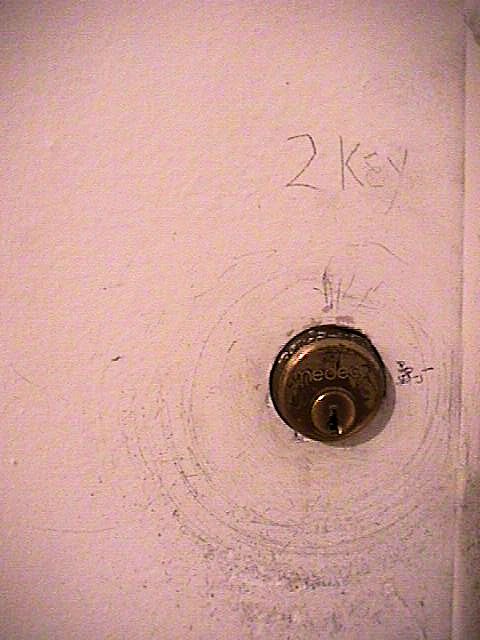
It takes "2 Key" to unlock Étant donnés's back door.
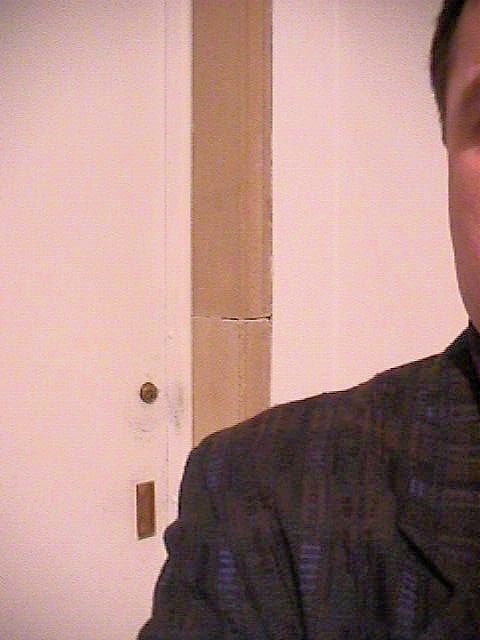
Fractional self portrait with Étant donnés's back door.
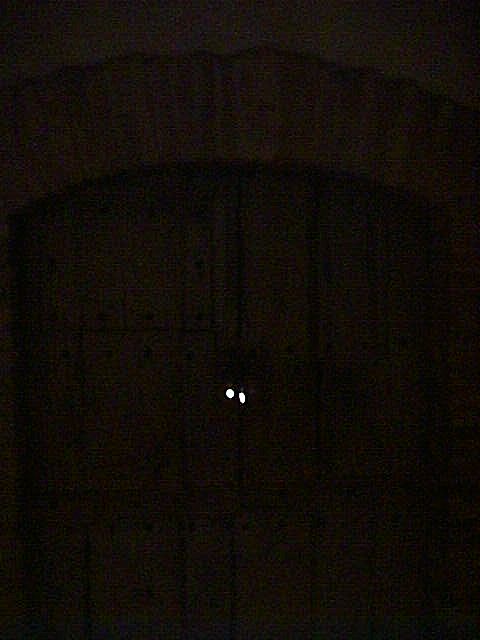
Étant donnés's front door.
13 March 2005
Re: Versailles, sigh
Thanks for the Freud references, B. Lots of food for further thought regarding the Stotesbury story. I have to say, however, that the Freud quotation--"The Rome Analogy tries to explain how memory works through the analogy of the preservation of the archaeology of Rome. The problem arises when one tries to imagine a Rome in which every building and statue of each period of Roman history is imagined existing complete and at the same time."--more or less describes exactly what Piranesi already did with the Ichnographia Campus Martius. In fact, a quotation from Freud's Civilization and its Discontents--"And now, I think, the meaning of the evolution of civilization is no longer obscure to us. It must present the struggle between Eros and Death, between the instinct of life and the instinct of destruction, as it works itself out in the human species. This struggle is what all life essentially consists of, and the evolution of civilization may therefore be simply described as the struggle for life in the human species."--was prelude to the 1999 presentation (in schizophrenia + architectures) of "Eros et Thanatos Ichnographia Campus Martius". Of course, I see this "struggle between Eros and Death" as nothing more than a reenactment of the metabolic process that keeps every human alive.
13 March 2007
...and speaking of random tangents
wild turkey sighting; 2007.03.13 12:45; Ury
driving around the block on the way to market...
"Look, there's a big bird walking across the road. Is that a turkey?"
The bird is walking very slow. Is it wounded? We slowly drive by a few feet away.
"I think it's very old."
"It's probably just going back into the woods."
Within the various biographies of John James Audubon you'll find ongoing discrepancies regarding his whereabouts during his first several months in the United States. The discrepancies stem mostly from the biographers not knowing where Ury actually was.
For the record, Audubon arrived from France at New York City sometime August 1803. The first thing he did was go to a bank in Greenwich [Village] where Audubon's father had money waiting for his son. Within a day or two Audubon became very ill. The ship's captain had Audubon taken care of by two Quaker women at Morristown, New Jersey (25 miles west of New York City). Miers Fisher, the agent of Audubon's father, went to collect the young Audubon once he was well again and brought him back to Ury. Audubon stayed at Ury perhaps as much as a few months, but then insisted he be taken to Mill Grove, his father's farm not far from Norristown, Pennsylvania.
And from there on Audubon's life is like one seemingly random tangent after another.
Back to France, back to Mill Grove, Pittsburgh, PA, raft down the Ohio River, Louisville, KY, Henderson, KY, then somewhere along the Mississippi where the Ohio River enters, then down to New Orleans, then north on the Mississippi again, then back to New Orleans, then back to Philadelphia, then back to New York, then Liverpool, England, then Manchester, then London...(this is where I stopped reading one of the biographies, and I may have messed up a little on the sequence of places). And this was just the first 15 years or so since Audubon first came to the US.
I hope that wild turkey made it safely back into the woods. Are wild turkeys among the Birds of America?
13 March 2023 Monday
"In the future, all the world's a next project projectile stage."
|